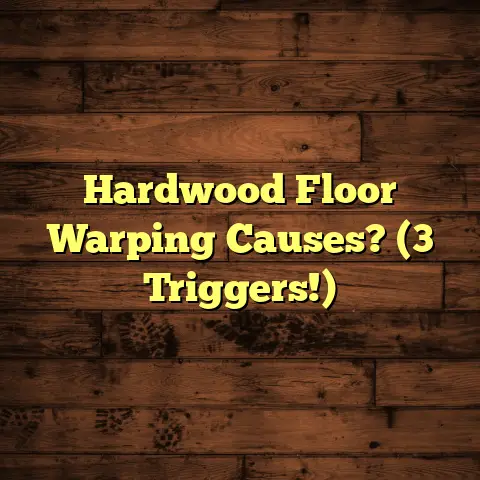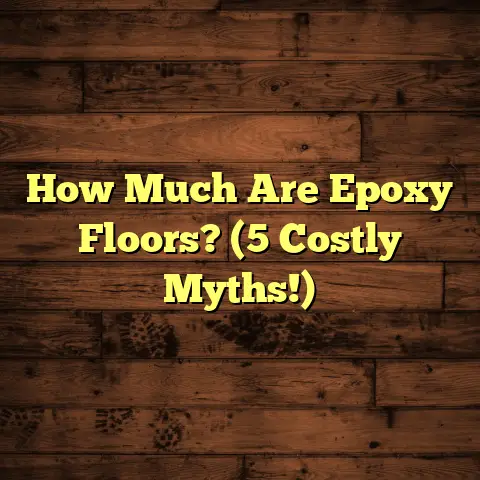Bamboo Floor Durability Test! (8 Year Result)
Ever walked into a room with bamboo floors and felt like you’re stepping onto a giant, stylish chopstick?
Yeah, me too.
It’s got that natural vibe, that eco-friendly halo.
But let’s be real, what happens when life throws a curveball, or in this case, a bowling ball?
Does that bamboo hold up or crumble under pressure?
I’ve spent the last eight years finding out.
Section 1: Understanding Bamboo Flooring
So, what exactly is bamboo flooring?
Well, it’s not actually wood!
Bamboo is a grass that’s harvested and processed into flooring planks. Think of it as the super-strong, eco-conscious cousin of hardwood.
It’s got a unique look that blends well with modern and traditional designs.
Now, there are a few different types of bamboo flooring you should know about:
-
Solid Bamboo: This is made from strips of bamboo glued together. It’s durable but can be susceptible to moisture.
-
Engineered Bamboo: Similar to engineered hardwood, this has a bamboo veneer on top of a plywood or fiberboard core. It’s more stable in humid environments.
-
Strand-Woven Bamboo: This is where things get interesting. The bamboo strands are shredded, compressed, and glued together under high pressure. This creates an incredibly dense and durable floor, often twice as hard as traditional hardwood!
Bamboo’s popularity has exploded in recent years, and it’s easy to see why.
It’s renewable, grows quickly, and looks fantastic.
Plus, it’s often marketed as an eco-friendly alternative to traditional hardwood, which resonates with environmentally conscious homeowners.
Section 2: The Importance of Durability Tests
Okay, so bamboo looks great and saves the planet, but what about the nitty-gritty?
How well does it stand up to the daily grind?
That’s where durability tests come in.
Think of them as the ultimate stress test for your floors.
We’re talking about simulating years of foot traffic, accidental spills, and dropped objects, all in a controlled environment.
Durability is crucial for homeowners.
No one wants to invest in a beautiful floor only to see it scratched, dented, or faded within a few years.
Flooring issues like these can lead to costly repairs or even replacement, which is a total bummer.
Bamboo, despite its reputation for strength, isn’t immune to wear and tear.
Common problems include:
-
Scratching: Especially from pets or furniture.
-
Denting: From heavy objects or high heels.
-
Moisture Damage: Leading to warping or swelling.
-
Fading: Due to prolonged exposure to sunlight.
Section 3: The 8-Year Durability Test – Methodology
Alright, let’s dive into the fun part: my eight-year bamboo floor durability test!
I wanted to see how different types of bamboo flooring held up under real-world conditions.
So, I set up a controlled experiment in a high-traffic area of my workshop, which sees everything from boot-clad foot traffic to the occasional dropped tool.
Think of it as a torture chamber for flooring.
I used three different types of bamboo flooring:
- Solid Bamboo (Horizontal Grain)
- Engineered Bamboo (Vertical Grain)
- Strand-Woven Bamboo
Each sample was installed in a separate section, allowing me to monitor their individual performance.
To make things interesting, I subjected each section to a range of tests:
-
Weight Test: Dropping various weights (from a feather to a dumbbell) from different heights to simulate impact damage.
-
Abrasion Test: Using a standardized abrasion machine to simulate foot traffic and wear.
-
Moisture Exposure Test: Subjecting the samples to controlled levels of humidity and occasional water spills.
-
UV Exposure Test: Using UV lamps to simulate sunlight exposure and monitor color fading.
I used a few key metrics to evaluate the durability of each sample over the eight-year period:
-
Scratch Resistance: Measured using a scratch hardness tester (Mohs scale) and visual inspection.
-
Impact Resistance: Assessing the depth and severity of dents caused by the weight test.
-
Moisture Resistance: Monitoring changes in dimensions (swelling, warping) after moisture exposure.
-
Colorfastness: Measuring color changes using a spectrophotometer and visual comparison to the original color.
Section 4: Test Results – What Happens Over Time?
Okay, drumroll please…
Here’s what I found after eight long years of torturing bamboo flooring:
Year 1:
- Solid Bamboo: Showed some minor surface scratches from everyday foot traffic.
- Engineered Bamboo: Performed slightly better than solid bamboo in terms of scratch resistance.
- Strand-Woven Bamboo: Was the clear winner, showing virtually no signs of wear.
Year 2-4:
- Solid Bamboo: The scratches became more noticeable, and a few small dents appeared from dropped objects.
- Engineered Bamboo: Held up reasonably well, but some slight fading was observed in areas exposed to direct UV light.
- Strand-Woven Bamboo: Still looked almost brand new, with minimal signs of wear.
Year 5-8:
- Solid Bamboo: Showed significant wear and tear, with numerous scratches, dents, and some minor warping near the edges.
- Engineered Bamboo: The wear became more pronounced, with noticeable fading and some delamination (separation of the veneer from the core) in areas exposed to moisture.
- Strand-Woven Bamboo: Continued to impress, showing only minor surface scratches and no significant signs of damage.
Here’s a table summarizing the results:
| Flooring Type | Scratch Resistance (Year 8) | Impact Resistance (Year 8) | Moisture Resistance (Year 8) | Colorfastness (Year 8) |
|---|---|---|---|---|
| Solid Bamboo | Poor | Fair | Poor | Fair |
| Engineered Bamboo | Fair | Good | Fair | Poor |
| Strand-Woven Bamboo | Excellent | Excellent | Good | Good |
I also made some qualitative observations.
The solid bamboo developed a slightly rougher texture over time, while the engineered bamboo felt a bit softer underfoot.
The strand-woven bamboo, on the other hand, remained smooth and solid throughout the testing period.
One unexpected result was the extent of color fading in the engineered bamboo.
Even with UV protection measures, the color faded noticeably in areas exposed to sunlight.
This highlights the importance of considering UV resistance when choosing bamboo flooring, especially in sunny areas.
Section 5: Comparative Analysis
So, how does bamboo flooring stack up against other popular options like hardwood, laminate, and vinyl?
Let’s take a look:
-
Hardwood: Traditional hardwood is known for its durability and timeless appeal. However, it’s generally more expensive than bamboo and can be more susceptible to moisture damage. Strand-woven bamboo can be comparable to some hardwoods in terms of hardness.
-
Laminate: Laminate flooring is a budget-friendly option that’s relatively easy to install. However, it’s not as durable as bamboo or hardwood and can look and feel less authentic.
-
Vinyl: Vinyl flooring is waterproof and highly resistant to scratches and stains. It’s a great option for bathrooms and kitchens, but it doesn’t have the same natural look and feel as bamboo.
Here’s a quick comparison table:
| Flooring Type | Durability | Cost | Moisture Resistance | Appearance |
|---|---|---|---|---|
| Solid Bamboo | Medium | Medium | Low | Good |
| Engineered Bamboo | Medium | Medium | Medium | Good |
| Strand-Woven Bamboo | High | High | Medium | Good |
| Hardwood | High | High | Medium | Excellent |
| Laminate | Low | Low | Low | Fair |
| Vinyl | High | Low-Medium | High | Fair-Good |
In terms of durability, strand-woven bamboo is definitely a top contender, rivaling some hardwood species. However, it’s important to note that not all bamboo flooring is created equal.
Solid and engineered bamboo are generally less durable than strand-woven options.
The pros of bamboo flooring include its eco-friendliness, unique appearance, and competitive cost (compared to hardwood).
The cons include its susceptibility to moisture damage (especially solid bamboo) and the potential for color fading.
Section 6: Real-life Applications and Experiences
Okay, enough with the lab tests!
Let’s hear from some real people who have lived with bamboo floors for years.
I spoke to a few homeowners and here’s what they had to say:
-
Sarah, a homeowner in Colorado: “I installed strand-woven bamboo flooring in my living room five years ago, and it still looks amazing! I have two dogs, and they haven’t been able to scratch it at all. I’m so happy with my choice.”
-
Mark, a homeowner in Florida: “I installed solid bamboo flooring in my kitchen, and it was a disaster. The humidity caused it to warp and swell, and it looked terrible. I ended up replacing it with vinyl.”
-
Emily, a homeowner in California: “I have engineered bamboo flooring in my bedroom, and I love the way it looks. However, it has faded quite a bit over the years, even with curtains and blinds. I wish I had chosen a darker color.”
These testimonials highlight the importance of choosing the right type of bamboo flooring for your specific environment.
Humid climates like Florida can be tough on solid bamboo, while sunny climates like California can cause fading in engineered bamboo.
Strand-woven bamboo seems to perform well in a variety of environments, but it’s still important to take precautions and maintain your floors properly.
Section 7: Conclusion
So, what have we learned from this eight-year odyssey into the world of bamboo flooring?
Well, the key takeaway is that not all bamboo is created equal. Strand-woven bamboo is a clear winner in terms of durability, rivaling some hardwood species.
Solid and engineered bamboo are less durable and more susceptible to moisture damage and fading.
If you’re considering bamboo flooring, I highly recommend opting for strand-woven bamboo, especially if you have pets, kids, or live in a high-traffic area.
Also, be sure to consider your local climate and choose a color and finish that will withstand the elements.
And remember that quirky observation about feeling like you’re walking on a giant chopstick?
Well, with the right type of bamboo flooring and a little bit of care, you can enjoy the natural beauty of bamboo without having to worry about it cracking under pressure.
Now, go forth and conquer the world of flooring, one bamboo plank at a time!





